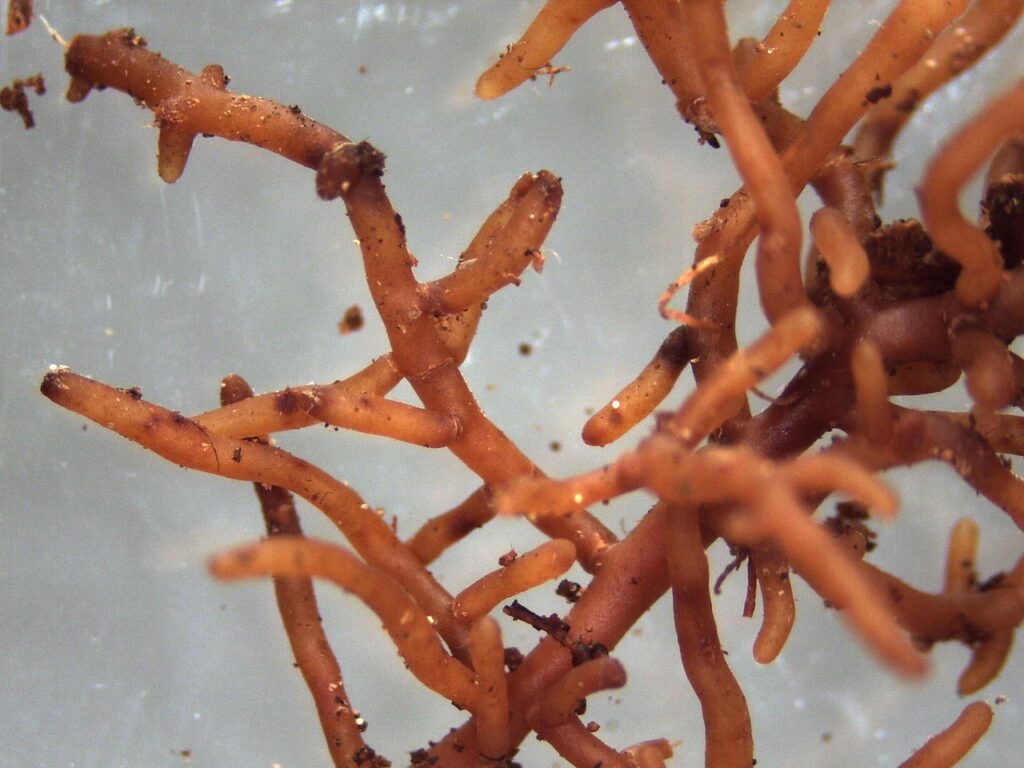
Mycorrhiza is a symbiosis between fungus and plant where the fungus hyphae penetrate the roots, resulting in a favourable nutrient exchange for both organisms. Fungi that form mycorrhiza are usually bound to one or a few specific plant species, and the fruiting bodies are only found near these. A majority of the mushrooms you pick in the forest are mycorrhizal. The yellow chanterelle is one of them, which explains why no one can grow the prized delicacy. The symbiosis is too complex to recreate [1].
The fungi’s thin threads of hyphae create a dense web through the soil where they penetrate. A single fungus can spread over several square kilometres over several hundred years, forming a web that holds an entire forest together. A teaspoon of forest soil can contain several kilometres of hyphae [2]. In fact, under every step you take in the forest, there are about 48 miles of fungi with all their branches. And this is true all over the world [3].
How trees benefit from mushrooms:
- Nutrient Absorption
Fungi act as extensions of tree roots and can access nutrients, especially phosphorus and nitrogen, that are difficult for trees to reach on their own [4]. - Water Supply
Through their network of hyphae, mycorrhizal fungi play a key role in improving water availability in trees. As water becomes more accessible, trees are more able to cope with drought [5]. - Communication
Mycelium communicates with electrolytes and electrical impulses like our brains [3]. The trees use these signals to feed and talk to each other, exchanging information about hazards such as drought and insects [2]. Plants also recognise their offspring in this way, allowing the mother tree and baby plant to communicate with each other. For example, suppose the mother tree knows that there are insect pests nearby and that she is in danger. In that case, she increases her competitiveness for her children, using mycelium so that they reproduce further away [3]. - Protection against Pathogens
Fungi act as a line of defence against harmful pathogens in the soil. They compete for space and nutrients, helping to protect trees from potential damage [6]. Still, they can also protect more specifically by providing plants with antibiotics to defend against parasitic attackers. This cooperation is so widespread that up to 85 per cent of all plants on Earth today need a fungal buddy to thrive [7].
How fungi benefit from trees:
- Carbohydrates
In exchange for nutrients, the fungi get back carbohydrates that the trees supply from their photosynthesis [7]. - Protection
Fungi benefit from the protective environment of the trees underground that prevents external influences [6]. - Propagation
Fungal spores can spread more efficiently through the tree’s root system, favouring the fungi in their reproduction [8].
Even shrubs, grasses, and perhaps all plant species have similar communication benefits to trees. But through plant breeding of the crops we grow today, they have largely lost the ability to communicate above and below ground. For example, they have become deaf and dumb, making them easy prey for insects. This breeding is one of the reasons why we use so many pesticides today [2].
Sources
- Photographer: Oliver Karlöf

- Good Reads – Peter Wohlleben – The Hidden Life of Trees

- Louie Schwartzberg – Fantastic Fungi Film

- New Phytologist – Mycorrhizal ecology and evolution: the past, the present, and the future

- ScienceDirect – Mycorrhizal Symbiosis

- Nature Communications – Mechanisms underlying beneficial plant–fungus interactions mycorrhizal symbiosis

- Marcus Rosenlund (2022) – Det stora lilla livet

- New Phytologist – Observations on the mycorrhizal status of some alpine plant communities

April 2023, TÄNKOM | Revised March 2024 RETHINK



